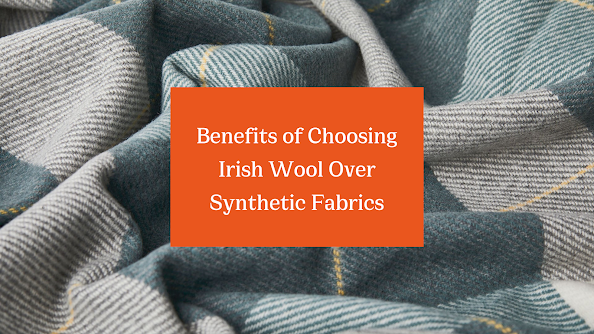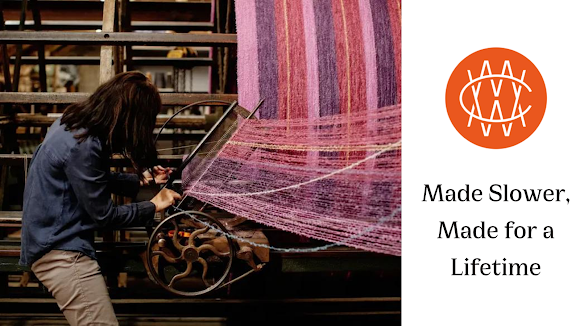The Environmental Benefits of Choosing Irish Wool Over Synthetic Fabrics
The environmental effects of the textile and fashion industries have drawn attention in recent years. The increasing consciousness about sustainability is encouraging consumers to make more environmentally friendly decisions, from fast fashion to synthetic fabrics. Choosing to utilize natural wool instead of synthetic fabrics is one such decision that has numerous positive environmental effects. Irish wool, especially lambswool and mohair, is particularly notable for its superior attributes. This essay will discuss the environmental benefits of selecting Irish wool over synthetic materials, in addition to making sense fashion-wise and for your home.
The Natural Properties of Wool
In terms of environmental benefits, wool is unmatched by synthetic fabrics like polyester, nylon, and acrylic. Particularly Irish wool is renowned for its exceptional quality and sustainability. Compared to synthetic counterparts, it requires a lot less energy to produce and is renewable and biodegradable.
Wool naturally breaks down in soil upon disposal, returning vital nutrients to the soil without producing hazardous microplastics. In contrast, synthetic fabrics can take hundreds of years to decompose, contributing to plastic pollution in landfills and oceans.
Another renewable resource is wool. Every year, sheep are sheared, and the wool regrows to ensure a steady supply without depleting resources. This stands in stark contrast to synthetic fabrics, which are derived from petroleum—a finite resource with significant environmental implications.
The Eco-Friendly Production of Irish Wool
Sustainable farming practices are in line with the long-standing traditions of Irish wool production. In Ireland, sheep farming is essential to preserving the nation's natural environment, fostering biodiversity, and bolstering rural economies. The Irish Woollen Mills have maintained traditional methods that protect the environment and create superior goods, such as the wool blankets for which Ireland is renowned.
Sheared from a lamb's first fleece, lambswool is a type of wool prized for its warmth and softness. Angora goats produce mohair, which is another sustainable choice. The Irish Woollen Mills have preserved age-old techniques that respect the environment while producing high-quality products like wool blankets Ireland is famous for.
Wool vs. Synthetics: Environmental Impact
Its low carbon footprint is one of the main environmental advantages of using Irish wool over synthetic fabrics. Large amounts of energy, mostly from fossil fuels, are needed to create synthetic fabrics. For example, the production of polyester releases hazardous chemicals and greenhouse gases into the atmosphere, exacerbating pollution and global warming.
Irish wool production, on the other hand, causes the least amount of environmental harm. When processing wool, less water and chemicals are usually used than when producing synthetic fabrics. Additionally, wool products, such as wool blankets Ireland is renowned for, are more durable and longer-lasting, reducing the need for frequent replacements and thus lowering the overall demand for new materials.
The release of microplastics from synthetic fabrics during washing, which wind up in our rivers and oceans, is another significant distinction. The ecosystems and marine life are seriously threatened by these minuscule particles. On the other hand, because natural wool doesn't shed dangerous microplastics, it doesn't add to this problem. In actuality, wool fibres that end up in the environment decompose organically and enrich the soil with nutrients.
Insulation and Breathability: Health and Energy Efficiency
Irish wool has advantages for the environment, but it also provides better breathability and insulation, which boost energy efficiency and enhance health. For example, wool blankets are breathable and offer great warmth, which helps the body regulate its temperature more effectively.
Wool's inherent ability to breathe lessens the need for artificial heating or cooling agents in textiles used for clothing and home furnishings. Due to its insulating qualities, wool saves energy in homes by decreasing the need for artificial heating, especially in the winter. Selecting wool products for blankets and bedding thereby lowers energy use and lowers carbon emissions indirectly.
Wool is also naturally resistant to mould, mildew, and dust mites, making it a healthier material for those who suffer from allergies or asthma. Wool naturally wicks moisture away, making an environment more comfortable and hygienic than synthetic fabrics, which can trap moisture and promote bacterial growth.
The Role of Irish Wool in Sustainable Fashion
Irish wool is growing in popularity among consumers who are concerned about the environment as the global fashion industry shifts toward more sustainable practices. Wool products, which range from apparel to home textiles, are notable for their sustainability in addition to their visual appeal. For instance, Irish wool blankets blend environmental responsibility with skillful craftsmanship, making them a wonderful complement to any house that promotes eco-friendly living.
Purchasing Irish wool also helps to maintain traditional craftsmanship and local economies. Many Irish Woollen Mills operate with a commitment to sustainable practices, ensuring that their products have a minimal environmental impact while maintaining a high standard of quality. By choosing Irish wool over synthetic fabrics, consumers contribute to the protection of natural resources and the reduction of waste.
Conclusion
Making environmentally friendly decisions is more important than ever in a time when environmental awareness is growing. With its organic, sustainable, and biodegradable qualities, Irish wool presents a strong contender as a substitute for synthetic materials. Irish wool represents the ability of nature to lessen our impact on the environment, both in terms of its long-lasting and energy-efficient benefits and its environmentally friendly production methods.
Selecting wool over synthetics, whether it's an elegant lambswool scarf or a cozy wool blanket from Ireland, is a step in the direction of a more sustainable future. Customers who purchase Irish wool products appreciate the classic quality and robustness of natural fibers while simultaneously helping to preserve the environment.

.png)
.png)

Comments
Post a Comment